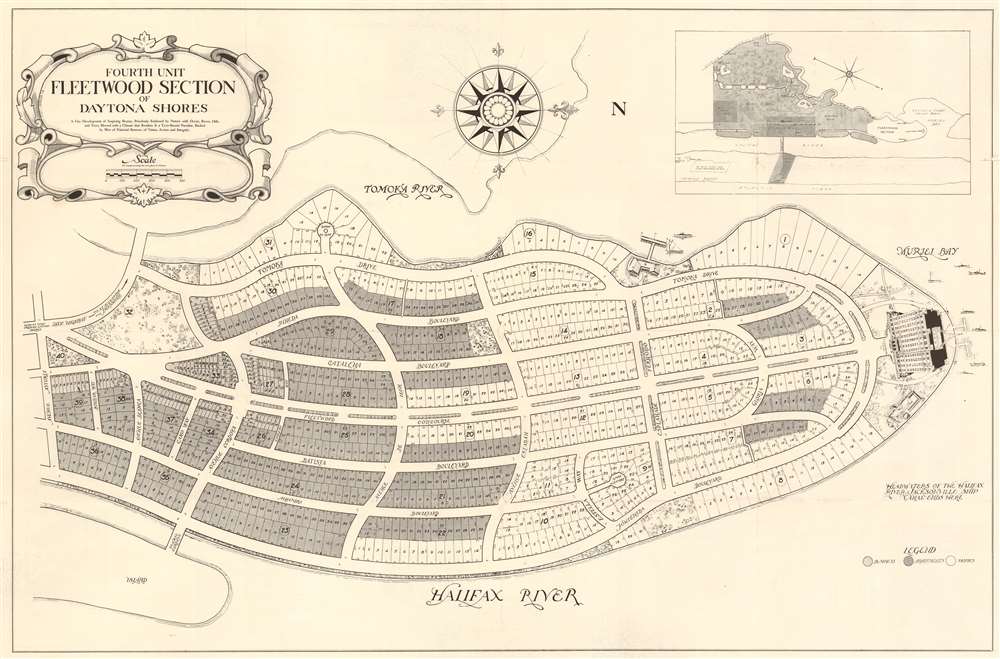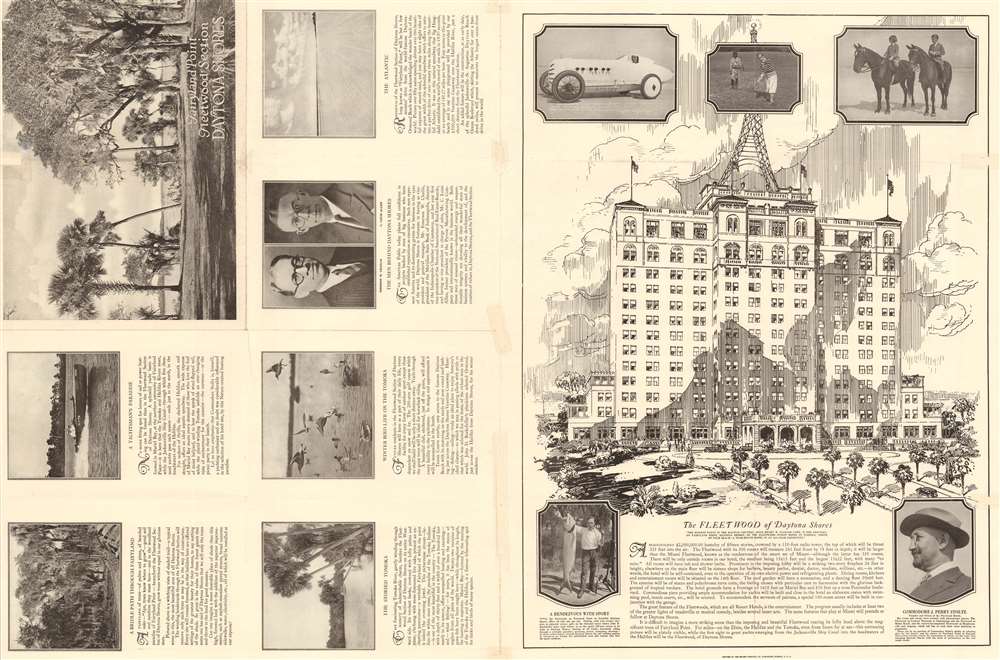This item has been sold, but you can get on the Waitlist to be notified if another example becomes available, or purchase a digital scan.
1926 Stoltz Map of Daytona Shores, Florida
FleetwoodDaytonaShores-stoltz-1926
Title
1926 (undated) 22.75 x 34.75 in (57.785 x 88.265 cm) 1 : 2400
Description
Daytona Shores
Daytona Shores was proposed by the wealthy hotelier and land speculator 'Commodore' J. Perry Stultz. Stultz saw the development as an opportunity to expand his network of luxury hotels. His newest hotel, known as 'The Fleetwood of Daytona Shores' was set to be the subdivision's focal point:The Fleetwood with its 300 rooms will measure 241 feet front by 78 feet in depth; it will be larger than the Miami Fleetwood, known as the rendezvous of the smart set of Miami - although the latter has 350 rooms…Prominent in the imposing lobby will be a striking two-story fireplace 24 feet in height, elsewhere on the main floor will be sixteen shops for barbers, beauty parlor, dentist, doctor, modiste, milliner, etc. - in other words, the hotel will be self-contained, even to the operation of its own electric power and refrigerating plants.Daytona Shores was subdivided into hundreds of lots for homes (all of which are identified here) and miles of streets were laid out. In September 1926, Stoltz's Miami property was destroyed by a hurricane. By this time over $87 million had been invested in Daytona Shores, leaving him in dire straits. It appears Stoltz's ambitious plans were blown away by that hurricane as well. Between that disaster, the end of the Florida land boom, and the Great Depression, Stoltz was ruined. Moreover, conservationists and environmentalists opposed Stoltz's plan, even in the 1920s, and had petitioned the state of Florida to create a state park in the area.
Florida Land Booms
In the second half of the 19th and throughout the early 20th century, Florida experienced a series of land booms and crashes. The first followed the Second Seminole War (1835 - 1842), when the government offered homesteaders who agreed to stay five years 160 acres of free land. The second boom followed the arrival of the railroads to central Florida, leading to nearly 15 years of prospered and economic growth - mostly revolving around the booming citrus industry. New settlements sprang up throughout the northern half of the state, many owned by absentee inventors who never personally visited Florida. The boom collapsed in 1894-95 when a series of historic freezes wiped out the citrus harvest. Property depreciation following the freezes allowed Henry Flagler (1830 - 1913) to develop the Florida East Coast Railway. This, and the arrival of the highway system in the 1920s, led to the third Florida land boom - represented here - from 1920 to the stock-market crash of 1929.Publication History and Census
This map was published by J. Perry Stoltz c. 1926 to promote his Daytona Shores subdivision and his new Fleetwood Hotel. An OCLC record exists for a 'brochure' with the title 'Fairyland Point Fleetwood Section Daytona Shores' and identifies eighteen copies in institutional collections. We have found no other instances of the present map or brochure appearing on the private market.Cartographer
Jacob Perry Stoltz (November 1, 1870 - September 4, 1945) was an American businessman and real estate developer. Self-styled as 'Commodore J. Perry Stoltz', he was born in Reading Township, Ohio. He made a fortune designing 'go-ball' a forerunner of the modern pinball machine. He sold these games to amusement park arcades and later sold the company. He invested this money in apartment buildings in New York City and, in 1913, purchased land in Miami Beach, Florida. There he built the Fleetwood Hotel, a fifteen story fireproof luxury hotel that opened in the 1920s. He also operated Miami Beach's first radio station, WMBF, from the Fleetwood Hotel's ballroom and had a transmission tower on the hotel's roof. In 1925-26, Stoltz began an ambitious series of projects, including building new hotels in Hendersonville, North Carolina, and purchasing the Fruitland Nurseries in Georgia. He also planned an entire development called Daytona Shores in Florida based around a new Fleetwood Hotel. A hurricane devastated Miami and Miami Beach in 1926 and destroyed the Fleetwood Hotel in Miami Beach. Between the destruction of his flagship hotel and the bust of the Florida land boom, Stoltz had to file for bankruptcy. None of the projects he had in progress were completed and he moved back to Ohio, where he reportedly lived in poverty for the rest of his life. As a historical side note, the Fruitland Nurseries are now Augusta National Golf Club. More by this mapmaker...




